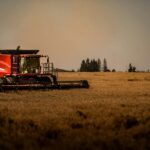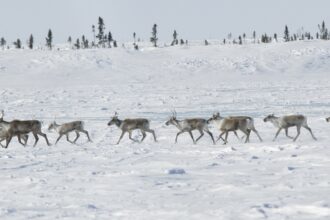As dawn broke over major Canadian cities this morning, residents awoke to an eerie orange sky and the acrid smell of smoke—a grim reminder that wildfire season has arrived with unprecedented intensity in 2025. Environment Canada has issued air quality alerts for vast regions across the country, from British Columbia to Atlantic Canada, as smoke from hundreds of active wildfires drifts thousands of kilometers from its source.
“We’re seeing particulate matter readings that are five to seven times higher than what we would consider safe for vulnerable populations,” said Dr. Amelia Richardson, respiratory health specialist at Toronto General Hospital. “This isn’t just a visibility issue—it’s a significant public health emergency.”
In Vancouver, where the Air Quality Health Index reached 9 out of 10 yesterday, health officials have advised residents to postpone outdoor activities. Similar warnings extend to Calgary, Edmonton, Winnipeg, and Toronto, where fine particulate matter has exceeded 150 micrograms per cubic meter—a level classified as “very unhealthy” by international standards.
The smoke originates primarily from massive wildfires burning in northern Alberta and British Columbia, but satellite imagery shows additional contribution from fires in Saskatchewan and Manitoba. Climate scientists note that the convergence of multiple fire zones has created what they’re calling a “smoke dome” over much of the country.
“What we’re witnessing is the direct result of climate change intensification,” explained Dr. Martin Chen, meteorologist at Environment Canada. “Higher temperatures, earlier spring melts, and drought conditions have created perfect conditions for these extreme fire behaviors.”
Particularly concerning to health experts is the prolonged exposure many Canadians now face. Unlike previous years where smoke events typically lasted days, forecasts suggest this episode could persist for weeks as firefighting efforts are hampered by challenging conditions and resource limitations.
The economic impact is already being felt across multiple sectors. Major airlines have canceled dozens of flights due to poor visibility, outdoor sporting events have been postponed, and tourism operators report significant cancellations during what should be the start of peak season.
The federal government announced yesterday it has activated the National Emergency Strategic Stockpile to distribute N95 masks to vulnerable populations. Meanwhile, provincial health ministries have opened clean air shelters in community centers and libraries for those without access to air conditioning or air purification.
“People with pre-existing respiratory conditions, the elderly, pregnant women, and young children should take extra precautions,” warned Dr. Richardson. “Even healthy individuals may experience symptoms like eye irritation, coughing, and shortness of breath.”
As Canadians adapt to what experts fear may become the “new normal” for summer seasons, the political discussion around climate change adaptation and mitigation strategies has intensified. Provincial leaders are calling for increased federal support for firefighting resources and infrastructure improvements to help communities become more resilient.
As smoke continues to drift across provincial boundaries and international borders, affecting air quality as far east as Maine and New York, the question remains: How will Canada balance immediate emergency response with the long-term investments needed to address the root causes of these increasingly severe wildfire seasons?














